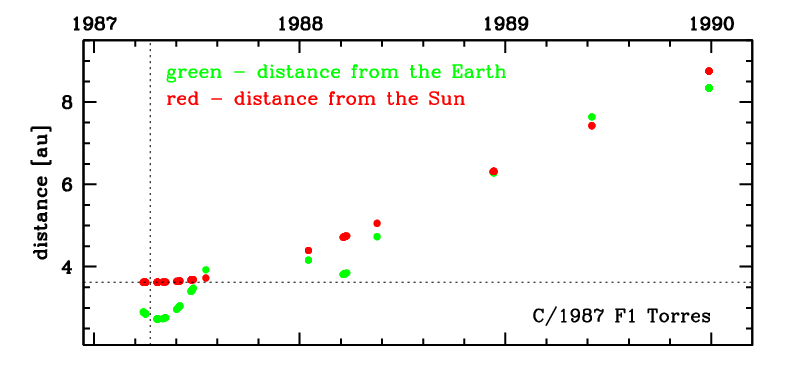C/1987 F1 Torres
more info
Comet C/1987 F1 was discovered by Carlos Torres (at Cerro El Roble) on 28 March 1987 (IAUC 4355), two weeks before its perihelion passage. The comet was last seen on 27 December 1989.
The comet made its closest approach to the Earth on 24 April 1984 (2.73 au), that was two weeks after its perihelion passage.
Solution given here is based on data spanning over 2.75 yr in a range of heliocentric distances: 3.63 au – 3.62 au (perihelion) – 8.75 au.
This Oort spike comet suffers small planetary perturbations during its passage through the planetary system that lead to a more tight future orbit (see future barycentric orbit).
See also Królikowska 2014 and Królikowska and Dybczyński 2017.
The comet made its closest approach to the Earth on 24 April 1984 (2.73 au), that was two weeks after its perihelion passage.
Solution given here is based on data spanning over 2.75 yr in a range of heliocentric distances: 3.63 au – 3.62 au (perihelion) – 8.75 au.
This Oort spike comet suffers small planetary perturbations during its passage through the planetary system that lead to a more tight future orbit (see future barycentric orbit).
See also Królikowska 2014 and Królikowska and Dybczyński 2017.
| solution description | ||
|---|---|---|
| number of observations | 56 | |
| data interval | 1987 03 28 – 1989 12 27 | |
| data type | significantly more measurements after perihelion (POST+) | |
| data arc selection | entire data set (STD) | |
| range of heliocentric distances | 3.63 au – 3.62 au (perihelion) – 8.75 au | |
| detectability of NG effects in the comet's motion | NG effects not determinable | |
| type of model of motion | GR - gravitational orbit | |
| data weighting | NO | |
| number of residuals | 108 | |
| RMS [arcseconds] | 1.14 | |
| orbit quality class | 1a | |
| orbital elements (heliocentric ecliptic J2000) | ||
|---|---|---|
| Epoch | 1987 03 26 | |
| perihelion date | 1987 04 10.27802900 | ± 0.00234800 |
| perihelion distance [au] | 3.62460449 | ± 0.00001506 |
| eccentricity | 1.00101531 | ± 0.00001802 |
| argument of perihelion [°] | 329.089760 | ± 0.000451 |
| ascending node [°] | 194.487714 | ± 0.000055 |
| inclination [°] | 124.079942 | ± 0.000075 |
| reciprocal semi-major axis [10-6 au-1] | -280.12 | ± 4.97 |
